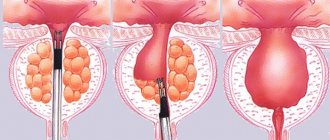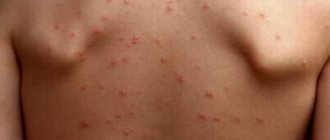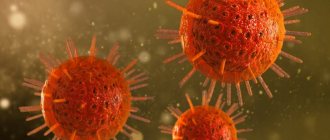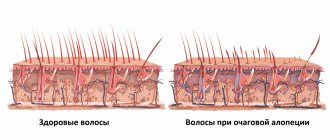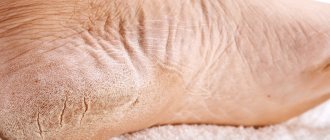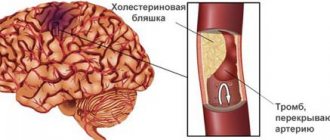Types of baldness in men
Depending on the type of baldness, the following forms are distinguished:
- alopecia areata - alopecia in men is caused by autoimmune processes and consists of the formation of an area without hair;
- diffuse – alopecia begins under the influence of external factors; the cause may be taking antibiotics, radiation, stress;
- androgenetic – most common in men; this alopecia begins with hair thinning, shortening and loss.
In most cases, baldness in men occurs due to the negative influence of hormones on the hair follicles. Some follicles are receptive to these hormones; This dependence is genetic and leads to the fact that men’s hair becomes thinner, its quantity decreases, which ultimately leads to baldness. In the normal state of affairs, some hairs fall out and are replaced by others. Alopecia is the predominance of hair loss processes over growth processes in men. For baldness:
- the hairline shifts, rising higher and higher from the forehead;
- hair on the forehead and crown of the head is thinning and falling out;
- areas of baldness increase and merge into a common area.
Diagnostics
Diagnosing alopecia is not difficult, since the patient has either a decrease in hair density or areas with a complete absence of hair. It is much more difficult to identify the cause of alopecia in order to prescribe a treatment regimen. To do this, you need to consult a trichologist.
Usually, a comprehensive examination of the patient is carried out, which includes a hormonal examination - a study of the functions of the thyroid gland and determination of the level of male hormones in the blood. A complete blood test is also necessary to identify or rule out dysfunctions of the immune system. It is necessary to exclude or confirm the syphilitic nature of alopecia, for which a serological blood test and an RPR test are performed. Patients with alopecia areata usually have decreased numbers of T and B lymphocytes and a positive hair pulling test—gently tugging on the hair shaft results in easy hair removal.
A microscopic examination of the hair shaft and foci of baldness for the presence of fungi is mandatory; a biopsy of the scalp can identify or exclude ringworm and cicatricial alopecia that have developed against the background of systemic lupus erythematosus, sarcoidosis, or against the background of lichen planus. Additionally, a spectral analysis of the hair is performed.
At what stage should treatment begin?
Baldness can be divided into several stages:
- 1 and 2 – signs of age-related baldness with changes in the bulb are observed; complete hair loss does not occur;
- 3 – in men, bald patches form at the temples;
- 4 – baldness is noted on the crown of the head;
- 5 – hair is actively falling out, distinct areas of baldness are forming on the crown and forehead;
- 6 – baldness becomes total due to the merging of areas;
- 7 and 8 – the remaining hair falls out.
Treatment
Once the diagnosis is established, treatment is aimed at eliminating the cause of alopecia and continues until hair growth is restored. Unfortunately, alopecia is quite resistant to treatment, although cases of self-cure have been described.
The doctor must convince the patient that the disease is long-term and it will take quite a long time to achieve the effect. Approaches to the treatment of alopecia are determined by the degree of its severity.
Treatment of alopecia areata with less than 50% hair loss
Corticosteroids are the mainstay of treatment:
- topically (applied to areas of baldness) in the form of creams or ointments - prednisolone, dexamethasone, triamcinolone, fluocinolone, etc.);
- intradermal injections into areas of baldness;
- Retin A preparations, preferably in the form of ointment or gel forms;
- Minoxidil, a drug used to treat arterial hypertension, has shown a fairly good effect for the treatment of alopecia. Its effectiveness is higher when combined with Retin A. With this combination, minoxidil is applied to bald areas in the morning, and retin is applied in the evening.
- zinc for oral administration has an immunomodulatory and antiandrogenic effect. But to achieve a therapeutic effect, fairly high doses will be required, and this, as a rule, leads to the development of side effects: nausea, vomiting, diarrhea.
- tar-like ointments (Ditranol), used in the treatment of psoriasis, are also suitable for topical use for alopecia.
- vitamin therapy - especially B vitamins (B1, B6, B12).
Treatment of alopecia areata with loss of more than 50% of hair
- Corticosteroids for systemic use (orally, injectable forms). Only the doctor controls the dose and duration.
- PUVA therapy: the patient takes a photosensitive substance, followed by ultraviolet irradiation. The procedure is carried out 2-3 times a week for 3 – 6 weeks.
- Irritating substances or allergens - topically on areas of baldness.
- Immunosuppressants (cytostatics) - in severe cases to suppress the autoimmune reaction.
Treatment of androgenetic alopecia includes the use of oral contraceptives for women; for men, a drug has been developed that suppresses the activity of 5-alpha reductase - Propecia. The drug is used once a day for 3 months.
Drugs used in other industries also have an antiandrogenic effect: spironolactone (veroshpiron) is a diuretic drug; cimetidine – reduces the acidity of gastric juice; ketoconazole (Nizoral) – intended to treat fungal infections; preparations based on polyunsaturated fatty acids.
Causes of the disease
A trichologist will help determine the reasons why baldness began and prescribe treatment in accordance with the diagnosis. To make a diagnosis, men undergo:
- examination of the scalp and hair;
- hair trichoscopy;
- clinical researches.
The doctor will also listen to your complaints and ask about your health. Consultations with other specialists may be required, since problems of baldness in men can be associated with diseases of the endocrine, nervous, and digestive systems. These diseases must be taken into account in treatment.
Factors of occurrence
Thinning of strands does not happen spontaneously; it is preceded by a whole complex of reasons. In most cases, the influence is exerted by heredity and hormonal levels, but there are other common reasons for the development of the disease:
1. Dramatic weight loss due to strict diets; 2. Impaired functioning of the immune system, previous viral or infectious diseases; 3. Adverse environmental factors, poor ecology; 4. Malfunctions of the endocrine system; 5. Constant temperature changes; 6. Diabetes mellitus; 7. Menopause; 8. Previous surgical operations under general anesthesia; 9. Poor blood supply to the scalp; 10. Poor nutrition; 11. Lack of vitamins and microelements; 12. Bad habits; 13. Iron deficiency anemia; 14. Regular stress, severe emotional shocks; 15. Use of drugs to normalize blood pressure, steroids and diuretics, antidepressants; 16. Radiation and chemotherapy.
Alopecia: basic treatment regimens for men
Depending on the established causes, the doctor will select a treatment regimen for baldness. Classic therapy includes:
- vitamin and mineral supplements;
- injections of drugs to combat the problem of baldness;
- physiotherapeutic methods of influence;
- normalization of nutrition, lifestyle, sleep patterns.
It is also necessary to treat the underlying disease if alopecia in a man appears as a consequence of it.
The fight against baldness takes a long time.
A man should prepare himself for 2-6 months of treatment, as well as subsequent maintenance therapy. The An-Tek Laboratory uses external medications approved for use by the Ministry of Health of the Russian Federation for treatment. With their help, hundreds of thousands of men in the USA, Canada, and Russia have already undergone treatment. With timely initiation of treatment, alopecia can be easily corrected. We recommend not to self-medicate, not to waste time on home remedies that cannot cope with such a serious problem, but to immediately start with treatment from a specialized specialist. Back to list of articles
Causes of scalp hair loss
It is known that the tendency to hair loss can be genetically determined (programmed), however, there are a number of other reasons that can contribute to the development of alopecia. Among them are:
- Regular stress;
- Hormone imbalance;
- Childbirth and the postpartum period;
- Unbalanced nutrition and uncontrolled diets;
- Unfavorable environmental situation;
- Mechanical or chemical damage to the scalp;
- Infectious processes.
In addition, hair loss may develop during specific treatment. Alopecia is often observed in patients who have undergone chemotherapy, as well as after long-term use of certain groups of antibiotics, antidepressants, systemic retinoids or other drugs.
Establishing the cause of hair loss is one of the most important tasks for a trichologist, since further treatment and its effectiveness will depend on this.
AGA cannot be treated; it is only possible to “freeze” the process.
If you visually notice obvious signs of hair loss, and receive “compliments” about your thinning hairstyle - as a rule, the point of no return has already been passed. As the colossal experience accumulated over the entire world history - from antiquity to the present day shows, none of the known remedies, from grandmother’s poultices to modern drugs, will give you relief from the process of androgenic alopecia. Rubbing the most popular burdock oil, egg yolk, nettle broth, onion juice, etc., self-massage of the scalp with your hands and a Lyapko applicator, and finally, “heavy artillery” in the form of special preparations - provide equally primitive stimulation of the growth of lost hair. These methods, accessible to the human mind, do not in any way eradicate the underlying causes of AGA and are unable to breathe full life into your dying vegetation on the top of your head. At first, the hair loss decreases, the fluff returns on the receding hairline, and you may think that you have truly overcome the process of baldness. But it’s too early to rejoice. Soon you notice that your retained and re-grown hair is less and less “grateful” to you for your efforts - it falls out more and grows back less and less. When folk self-medication becomes powerless against developing baldness, they move on to medical methods, which are also effective only at first. They will be discussed further.
Types of baldness
Baldness is classified into female and male pattern. In the first case, hair thinning begins from the parting area and then spreads in different directions. In extremely rare cases, hair falls out completely. Usually they become thin, brittle, grow poorly, and noticeably lose thickness. Female pattern baldness does not happen overnight; the hair leaves the crown gradually, in a “wavy” manner. In women, hair follicles do not die completely, so hair loss is reversible and can be cured. It is necessary to consult a trichologist, make an accurate diagnosis and competently prescribed therapy.
The main causes of female pattern baldness are hormonal changes in the body (for example, during pregnancy, after childbirth, during menopause). Hair loss can also be caused by frequent stress, diets (especially protein-free diets), and infectious diseases.
60% of the fair sex suffer from this problem.
Male pattern baldness is hair loss in a horseshoe pattern. Hair is rapidly falling out and thinning, first in the frontal area, then bald patches appear in the temple area, on the sides of the head. Finally, baldness spreads to the central part of the head. Hair almost never leaves the back of the head; most often men shave it off themselves. This type of pathology is also called androgenic alopecia, because its main cause is an excess of the male hormone testosterone in the body. Most often, baldness in men is caused by a hereditary factor. From a health perspective, the pathology is not dangerous, except that it can lead to a deterioration in a person’s emotional state. In this case, only hair transplantation can help as a method of therapy.
For those who suffer from androgenetic alopecia, experts recommend a transplant method such as HFE (Hand Follicle Extraction). Unlike other methods in which hair is transplanted along with areas of skin, HFE involves transplanting hair follicles directly. After such a procedure, there are no unsightly scars left, no numbness in the head, and no pain in the transplant area or donor area.
Male pattern baldness can also occur in women if they have excess testosterone in their bodies. Symptoms of androgenetic alopecia in a woman can be: deepening of the voice, increased hair growth in various parts of the body (arms, back), the growth of a noticeable black mustache, and others. In this case, women are usually prescribed hormonal therapy, and if it does not help, they are recommended to resort to hair transplantation. The above-mentioned HFE method, for example, can be completed at the Moscow Hair For Ever clinic, which is located near the Prospekt Mira metro station.
Baldness in children is classified as a separate type. Its causes are hereditary (hypotrichosis simplex is an irregular shape of receptors on the surface of hair follicles, resulting in hair growth blocking), congenital or acquired diseases (thyroid pathologies, systemic lupus, infectious diseases). Treatment methods for focal baldness involve stimulating hair follicles. To treat baldness in children, scalp massage, acupuncture, homeopathic remedies, herbal tinctures, fish oil, baths with mustard or with a solution of aspirin, primrose oil and flax are used. They also resort to drug therapy.
Pay attention
One of the causes of childhood baldness is trichotillomania, a condition of emotional distress in which a child consciously or unconsciously pulls out his or her hair.
Folk remedies
Traditional medicine can be used to treat alopecia. In order for them to have at least some effect and not cause harm, you should use traditional recipes only after consulting a doctor.
Often, to prepare formulations for home use you will need:
- burdocks;
- onion;
- hop;
- hot pepper;
- burdock.
Masks with these components help strengthen hair roots and awaken dormant follicles.
To improve blood microcirculation, masks are used:
- from aloe, honey, garlic;
- mustard;
- red pepper.
Some traditional healers recommend rubbing regular salt into the scalp. The method helps exfoliate dead skin particles.
Traditional medicine is usually used in courses. Each is 2 weeks, then a break of 5–7 days is recommended.
Medicines are no joke.
Today you are offered a symbiosis of 2 types of products: finasteride, dutasteride and propecia reduce the production of androgenic hormones allegedly responsible for baldness, minoxidil and alerana stimulate hair growth on bald spots. These drugs have been around for 30 years, if not more, and despite their time-tested weak, temporary effectiveness and dangerous side effects, they are successfully prescribed to patients. Beginners with naive faith and hope follow the advice of the “good” tricho-Aibolitov and... instead of hair on their bald head, they acquire impotence in the prime of their years. Because it is dangerous to mess with the “correction” of hormones; our body is much more complex than doctors think. Your fruits of treatment - thin hair, forcibly grown or kept in its rightful place through medicinal stimulation - resemble zombies raised from the grave, drug addicts, constantly demanding a dose, and even if they have it, their days are numbered. You yourself are literally sitting on the needle, taking 5,000-10,000 rubles a month from your family for medicines, until, in 5 years, you completely fall off.
Necessary prevention
Unfortunately, not all types of alopecia can be prevented. But in some cases, prevention can be a salvation from baldness.
Necessary preventive measures:
normalization of hormonal levels
· stress reduction
· normalization of sleep and rest patterns, proper nutrition
· performing physical exercises that improve blood circulation and lymph flow
· use of high-quality cosmetics
· preventive examinations and exclusion of diseases that indirectly affect the condition of the hair
The Nanoesthetic Center for Medicine and Aesthetic Cosmetology offers a number of procedures that improve the condition and growth of hair.
Seborrheic dermatitis
Seborrheic dermatitis is a scalp disease in which hair loss is common. Seborrhea comes in different types: oily, dry and mixed. With each, alopecia is possible.
Dermatitis is characterized by a number of symptoms: dandruff, itching, inflammation, a feeling of tightness, scabs. With oily seborrhea, dandruff is large and sticks to the hair; with dry seborrhea, it is small and easily falls off. Seborrhea hair loss occurs due to clogged pores and follicles, which impedes the flow of oxygen and nutrients to the scalp.
If you don't want to be bald, wear the system
Of course, the psychology of a balding person who rubs various potions into his head and donates his money to trichologists can be understood: it is better to run away from the onset of baldness, knowing that it will catch up anyway, than to wait passively. In general, baldness at an early age is a good reason to think about the correctness of your life. It is important to realize the karmic, psychosomatic reasons that caused AGA in you, as well as in your ancestors, and correct your thinking and lifestyle. Of course, this will have a beneficial effect on your future and your descendants. A balding person is often embarrassed by his “new image”, because of this, further aggravating his karma by missed opportunities and growing personal unfulfillment. But today there is a way out - surprisingly rational, bloodless, without contraindications or side effects, and, moreover, it is by no means the most expensive. This is the installation of the hair system. By returning your face to a natural look, you can better correct all the mistakes of the past, improve your personal life and career.
Published October 2, 2021
What is alopecia?
Alopecia translated from Greek means “baldness.” It is an unnatural hair loss that results in hair loss on the head as well as other parts of the body. The loss can be either partial or complete. The most common area that suffers from baldness is the scalp.
Each hair grows from a follicle (this is the hair follicle - the root with surrounding tissues, consisting of 20 different types of cells with different functions). At first, the hair is in the active growth stage - this phase is called anagen and lasts up to 5 years.
Next comes the second and shortest phase - catagen (the end of active hair growth), lasting up to four weeks. In this phase, the follicle enters the resting stage and hair growth stops.
After the follicle goes to sleep, the final phase begins - the resting stage of the follicle, which is called telogen. The hair follicle stops nourishing the hair; It continues to remain in the follicle for about 6-8 weeks, and then falls out. The first anagen phase begins again - the rested follicle again forms a new hair.
Each follicle, and there are several tens of thousands of them on the head, has its own rhythm and speed of phase changes, so hair continuously grows and falls out. On average, about 90% of all hair is in the anagen stage, 8% is in the final phase, which explains the normal process of hair loss.
The average rate of hair loss is from 80 to 150 pieces per day. If this amount is significantly higher than normal, it is recommended to consult a trichologist.
Carefully! Trichology!
Androgenic alopecia is a complicated issue. Little has been studied - this unpleasant, but non-life-threatening pathology gives life to a highly profitable medical and pharmacological business. The naive layman-novice unconditionally trusts the “achievements” of medicine of the 21st century and is easily led by advertising of trichoservices, which abound in many Internet sources on the topic of treatment of baldness. Various specialists and clinics offer treatment methods in all sorts of combinations - countless “vitamins” (internal and external), darsonval, mesotherapy, plasma lifting, and, finally, the legendary “couple” - finasteride and minoxidil. The benefits of medical treatment for AGA are comparable to homemade egg masks and self-massage with a needle roller. Even more dangerous are the “shadow” trichologists who offer their “super-nano-remedies on stem cells” for an incredible price. The only salvation from spending your hard earned money on “hairy” medicine is awareness of the scanty possibilities of healing from AGA. Manufacturers of AGA products will only be encouraged to develop and bring to market more effective products when masses of informed patients stop paying for existing useless procedures and harmful drugs.

